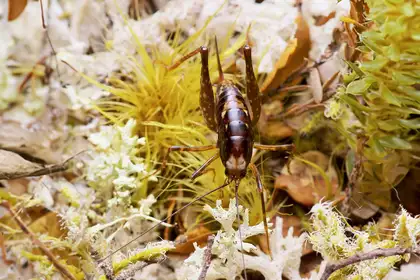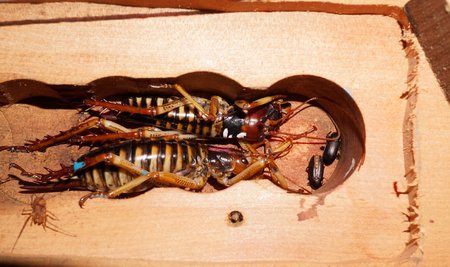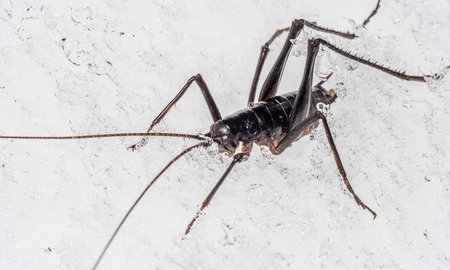
Occultastella morgana. Photo credit: Andy MacDonald.
Professor in Evolutionary Ecology Steven Trewick has detailed his discoveries in a newly published paper in Zootaxa, writing how the new species were immediately recognisable as novel discoveries.
Among the recent findings is the newly described genus Crux, with two new species: Crux boudica found in Rakiura Stewart Island and southwest South Island, and Crux heggi from northwest South Island.
“The genus Crux reflects the southern occurrence of this newly discovered diversity, and the type species Crux boudica is named for the Iceni queen due to the female’s heavily armed appearance. Crux heggi is named after Danilo Hegg, an orthopterist who collected specimens of this taxon and has made significant contributions to the study of New Zealand Rhaphidophoridae,” Professor Trewick says.
The second genus identified is Occultastella, meaning hidden star, which includes the newly discovered Occultastella morgana from northwest South Island. The species, characterised by its dark body and white flame-like markings on the head, was first found in 2012 among the coal measure soils of the Denniston Plateau and has since been located near Lake Rotoiti and in the Kahurangi region.
“Occultastella morgana was named in honour of Massey biologist Professor Mary Morgan-Richards, who has contributed extensively to the ecology, systematics and taxonomy of New Zealand Rhaphidphoridae and Anostostomatidae, as well as promoting women in science.”
Often referred to as wētā, these crickets are better called tokoriro to distinguish them from true wētā (Anostostomatidae). They belong to a family (Rhaphidophoridae) found worldwide but New Zealand has a rich, endemic fauna of the flightless crickets inhabiting forests, alpine zones and caves.
Despite their ecological significance, their taxonomy remains incomplete, with many species yet to be described with ongoing revisions at the genus level. Professor Trewick says the latest discoveries highlight the ongoing need for taxonomic research.
“The challenge in discovering the full extent of wētā diversity lies more in the availability of taxonomists than in the existence of undiscovered taxa. Dedicated survey efforts are crucial for species discovery and to deepen our understanding of New Zealand’s biodiversity.”
Related news
New research enables non-lethal monitoring of wētā
New research into the behaviour of tree wētā will enable better monitoring of the species without the need to kill them.

Researchers discover six new species of New Zealand wētā
Six new species and three new subspecies of alpine cave wētā from the southern regions of the South Island have been identified.

The secret sex lives of stick insects
Massey University researchers have discovered more about the sexual lives of stick insects in New Zealand and the United Kingdom.
